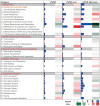Diet Composition Affects Liver and Mammary Tissue Transcriptome in Primiparous Holstein Dairy Cows
- PMID: 32674414
- PMCID: PMC7401567
- DOI: 10.3390/ani10071191
Diet Composition Affects Liver and Mammary Tissue Transcriptome in Primiparous Holstein Dairy Cows
Abstract
The objective of the present study was to evaluate the overall adaptations of liver and mammary tissue to a corn stover (CS) compared to a mixed forage (MF) diet in mid-lactation primiparous dairy cows. Twenty-four primiparous lactating Holstein cows were randomly allocated to 2 groups receiving either an alfalfa forage diet (MF, F:C = 60:40) with Chinese wildrye, alfalfa hay and corn silage as forage source or a corn stover forage diet (CS, F:C = 40:60). A subgroup of cows (n = 5/diet) was used for analysis of liver and mammary transcriptome using a 4 × 44K Bovine Agilent microarray chip. The results of functional annotation analysis showed that in liver CS vs. MF inhibited pathways related to lipid metabolism while induced the activity of the potassium channel. In mammary tissue, fatty acid metabolism was activated in CS vs. MF. In conclusion, the analysis of genes affected by CS vs. MF indicated mammary gland responding to lower level of linoleate from the diet (lower in CS vs. MF) by activating the associated biosynthesis metabolic pathway while the liver adaptively activated potassium transport to compensate for a lower K ingestion.
Keywords: corn stover; forage-to-concentrate ratio; liver and mammary gland; transcriptome.
Conflict of interest statement
All the authors declare no conflict of interest.
Figures





Similar articles
-
Dried distillers grains plus solubles with corn silage or alfalfa hay as the primary forage source in dairy cow diets.J Dairy Sci. 2007 Dec;90(12):5587-99. doi: 10.3168/jds.2006-753. J Dairy Sci. 2007. PMID: 18024751
-
Hepatic transcriptome perturbations in dairy cows fed different forage resources.BMC Genomics. 2021 Jan 7;22(1):35. doi: 10.1186/s12864-020-07332-0. BMC Genomics. 2021. PMID: 33413124 Free PMC article.
-
Effects of dietary forage sources on rumen microbial protein synthesis and milk performance in early lactating dairy cows.J Dairy Sci. 2013 Mar;96(3):1727-34. doi: 10.3168/jds.2012-5756. Epub 2013 Jan 4. J Dairy Sci. 2013. PMID: 23295118
-
Milk fatty acid profiles in Holstein dairy cows fed diets based on corn stover or mixed forage.Arch Anim Nutr. 2014;68(1):63-71. doi: 10.1080/1745039X.2013.869986. Epub 2014 Jan 14. Arch Anim Nutr. 2014. PMID: 24422608 Clinical Trial.
-
Transcriptional profiling of milk fat synthesis in mammary gland of dairy cows with different forage quality using RNA sequencing.Front Vet Sci. 2025 Mar 26;12:1469169. doi: 10.3389/fvets.2025.1469169. eCollection 2025. Front Vet Sci. 2025. PMID: 40206261 Free PMC article.
References
-
- Schingoethe D., Byers F., Schelling G. The Ruminant Animal: Digestive, Physiology, and Nutrition. Waveland Press Inc.; Long Grove, IL, USA: 1988. Nutrient needs during critical periods of the life cycle; pp. 421–447.
-
- Bergman E.N., Brockman R.P., Kaufman C.F. Glucose metabolism in ruminants: Comparison of whole-body turnover with production by gut, liver, and kidneys. Fed. Proc. 1974;33:1849–1854. - PubMed
Grants and funding
LinkOut - more resources
Full Text Sources
Molecular Biology Databases

